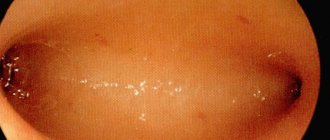Vaginal microflora. Why do we need bacteria?
The human body is inhabited by various microorganisms that help us live and our organs function fully. The microflora of the vagina of a woman of childbearing age differs in the composition of microorganisms from the flora of girls and women in menopause, since during this period the main purpose of a woman is fulfilled - the possibility of conceiving and bearing a child, that is, procreation.
What is the normal vaginal microflora?
Normally, the predominant number of microorganisms is lactobacilli. They create an acidic environment and produce antiseptic and antibacterial substances to fight dangerous (pathogenic) microbes. Also, a small amount contains opportunistic microorganisms, which, in the presence of the “leader” - lactobacilli, behave neutrally.
What microorganisms are considered opportunistic?
- Anaerobes - grow in oxygen-free conditions. There are many of them, but the leading ones are Gardnerella vaginalis and Atopobium vaginae. They practically do not grow in bacterial cultures; they are best detected by PCR
- Aerobes - they are also called “banal flora”. They grow in conditions of access to oxygen. Well identified in flora crops
- Fungi of the genus Candida
- Ureaplasma and Mycoplasma hominis
If the number of lactobacilli in the mass of microflora decreases, then opportunistic microorganisms begin to behave aggressively and can cause the following diseases, depending on which microbes are more active:
- Predominance of anaerobes – bacterial vaginosis
- Aerobes – bacterial vaginitis
- Candida – candidiasis, or thrush
- Ureaplasma and mycoplasma hominis - ureaplasmosis and mycoplasmosis
Diseases associated with opportunistic microorganisms are the common name for this group of diseases.
Why is the vaginal microflora disrupted?
- Sexually transmitted infections (STIs) are one of the leading causes. They are absolute pathogens. Their appearance and reproduction, in addition to a number of adverse consequences, leads to the suppression of normal flora - lactobacilli, and the growth of opportunistic microbes.
- Hormonal imbalances lead to imbalance of vaginal microflora.
- Long-term use of antibiotics suppresses lactobacilli not only in the intestines, but also in the vagina.
- Frequent change of sexual partners
- Long-term use of oral contraceptives and local contraceptives (intrauterine devices, vaginal rings)
- Some systemic diseases (diabetes mellitus, autoimmune diseases and others)
- Decreased general and local immunity
Why is a violation of the vaginal microflora dangerous?
Microflora disturbances can be manifested by white or grayish discharge, sometimes with an unpleasant odor. Itching and burning may occur when urinating. Or they may not appear at all. But in any case, an imbalance of microflora can cause the following conditions:
- Inflammatory diseases of the pelvic organs
- Infertility
- Habitual miscarriage
- Premature birth during pregnancy
- Complications when performing manipulations on the pelvic organs
How can vaginal microflora disorders be identified?
The most accurate method is PCR. But there is an important point here: for a comprehensive and complete assessment of the microflora, special tests are needed to determine the level of lactobacilli as the most important and necessary; and the level of opportunistic microorganisms in relation to lactobacilli. Such tests include:
- Femoflor – 8, Femoflor -16, Screening PCR-12
- Florocenosis – bacterial vaginosis, Florocenosis, Florocenosis (comprehensive study)
How to understand the result of the study?
The doctor does the decoding. The answer can be in the form of a graph (Femoflor) and a conclusion (Florocenosis)
If lactobacilli predominate, then everything is fine. If there are few or no lactobacilli, and any type of UPM predominates, the doctor compares the examination data, complaints and laboratory findings, makes a diagnosis and prescribes treatment.
Get examined in a timely manner with the KDL laboratory and be healthy!
What is the microflora of the oral cavity?
Surprisingly, approximately 160 species of microorganisms live in the mouth of a healthy person. You've probably heard that “the mouth is the dirtiest place in the body.” This statement is partly true: the oral cavity is one of the most populated parts of the human body.
Microorganisms enter the oral cavity with food and water, as well as from the air. It is in the mouth that the most favorable conditions for the development of bacteria are observed. This part of the body always has uniform humidity and temperature (approximately 37 °C). The abundance of nutrients, sufficient oxygen content, the presence of folds in the oral cavity, interdental spaces and gum pockets, and slightly alkaline pH provoke the proliferation of various bacteria.
Microorganisms are unevenly distributed in the oral cavity. Their maximum number is observed on the surface of the teeth and on the back of the tongue. One gram of dental plaque contains approximately 300 billion microbes, and saliva contains approximately 900 million per 1 milliliter.
- 30-60% of the microflora are facultative and obligate anaerobic streptococci;
- part is occupied by Veillonella, coccobacteria, which ferment acetic, pyruvic and lactic acids to water and carbon dioxide. It is Veillonella that neutralizes acidic foods, so many dentists consider them as destroyers of cariogenic bacteria;
- Bacteria of the genera Propionibacterium, Corynebacterium and Eubacterium are also necessarily present in the mouth, which actively produce molecular oxygen, synthesize vitamin K and promote the development of obligate anaerobes. Some types of such bacteria provoke purulent inflammation.
- Lactobacilli are strict anaerobes. There are more than 10 types of similar bacteria in the mouth that form a biofilm in the cavity. The vital activity of these microorganisms creates a favorable environment for the development of normal microflora. Lactobacilli ferment carbohydrates to form lactic acid, lower the pH, and most importantly, prevent the development of pathogenic, putrefactive and gas-forming microflora.
- Rod-shaped lactobacilli in a certain amount are, like streptococci, producers of lactic acid.
- Bifidobacteria are necessary to ferment various carbohydrates, as well as produce B vitamins and antimicrobial substances that inhibit the growth of pathogenic microorganisms. Moreover, bifidobacteria are a bunch of epithelial cell receptors: they form a film that prevents the colonization of pathogenic bacteria.
It would take a very long time to list all the types of bacteria that populate the microflora of the oral cavity. It is important to understand that each person is unique, and to assess the “normality” of the microflora, you need to know the characteristics of a particular organism.
For example, in one case, a large number of lactobacilli in the oral cavity will preserve teeth, and in another, the formation of a large amount of lactic acid during their vital activity will retard the growth of other important microorganisms. The number of staphylococci, dysentery and typhoid bacilli decreases, carious processes become more active, and the microflora of the oral cavity will have to be restored.
How to reduce acidity in the vagina for conception?
Increased vaginal acidity
Increased vaginal pH levels do not create the most favorable environment for sperm. This unique protective mechanism ensures that only the fastest, healthiest and strongest sperm can reach the egg for fertilization. In some cases, this interferes with conception.
Disturbance of oral microflora: causes
Oral dysbiosis can be caused by a variety of diseases and problems. Violation of opportunistic microflora of the oral cavity most often causes problems such as:
- Diseases of the gastrointestinal tract. Malfunctions of the digestive organs lead to a slowdown in metabolic processes in the body. The absorption of vitamins and nutrients deteriorates, the balance of the intestinal bacterial environment is disrupted, which provokes problems in other organs and systems.
- Decreased immunity. If the body's resistance deteriorates, the oral cavity automatically becomes more vulnerable to pathogenic microflora.
- Chronic diseases. Often, small caries or stomatitis, if left untreated, can spread from the source of inflammation to the entire oral cavity.
- Bad habits, such as systematic drinking of alcohol and smoking, inevitably affect the quality of the salivary glands. Prolonged drying out or too much moisture in the oral cavity has a detrimental effect on the composition of the microflora.
- Poor nutrition and lack of vitamins worsens the quality of saliva and makes the microflora of the oral cavity more vulnerable.
- Taking antibiotics and certain medications, such as hormones;
- Wearing dentures.
Possible complications of dysbiosis
It is important for each patient to closely monitor the state of the oral microflora. Lack of treatment for dysbiosis can lead to such unpleasant diseases as:
- pathological halitosis – bad breath caused by an imbalance of the oral microflora;
- caries – destruction of hard tooth tissues;
- pulpitis - inflammation of the pulp - the internal tissues of the tooth;
- periodontitis – inflammation of the tooth root membrane and adjacent tissues;
- gingivitis – inflammation of the oral mucosa;
- stomatitis – damage to the oral mucosa;
- periodontitis is a deep lesion of the periodontal tissue.
In addition, the close relationship between the state of the oral microflora and the state of the cardiovascular system has been scientifically proven. In 2008, it was proven in the USA that periodontal disease, as a source of chronic inflammation, is an independent risk factor for coronary heart disease (CHD).
So, now you know the role of normal oral microflora in the human body. Treat yourself carefully, and your healthy body will delight you every day.
Vaginal acidity test
Test strips for determining vaginal pH
There are special test strips for determining vaginal pH, which help identify the level of acidity at home, without contacting a gynecologist. They are freely available, sold in most pharmacies and available without a prescription.
Test strips for determining vaginal acidity are small pieces of special gray-green paper. To check the pH yourself, you need to open the test package immediately before taking the measurement, since prolonged exposure to air can affect the accuracy of the test strip. Next, you need to apply the strip to the vaginal wall for a few seconds (the exact time is usually indicated by the manufacturer on the packaging), then remove it and compare it with the color scale included in the test kit. When exposed to an acidic environment, the color of the strip changes, and this helps determine changes in the acidity of the vagina. If the result does not correspond to any of the given shades of the verification scale, you need to select the closest color.
Popular questions
I need a product with a neutral ph, and another very important point is that I am allergic to many intimate hygiene products from well-known brands.
Are your products hypoallergenic and what can you recommend to me? In your case, Ginocomfort gel with mallow extract is suitable if you are not allergic to its components indicated in the instructions.
Hello, what is the pH of the creams?
Gynocomfort gels containing lactic acid (washing gel for intimate hygiene and restoring gel with tea tree oil from the Gynocomfort line) have a pH of 4.2, which corresponds to the slightly acidic environment of the genital tract. Gynocomfort moisturizing gel has a neutral pH environment.
I can’t find a gel with a neutral pH (lichen sclerosus).
Hello! In your case, Ginocomfort gel with mallow extract is suitable. This will provide anti-inflammatory and moisturizing effects. The gel is applied once a day, the duration of use is not limited.
Hello, is it possible to use GINOCOMFORT intimate restorative gel for everyone to prevent problems, or are there any contraindications?
Hello!
Gels from the Gynocomfort line can be used as prophylactic agents. Contraindication is individual intolerance to the components of the product. For an accurate diagnosis, contact a specialist
How to increase vaginal acidity and why might this be necessary?
From a medical point of view, it is more correct to talk not about increasing the pH level of the vagina, but about its restoration and normalization. To do this, you need to make an appointment with a gynecologist, who will select the appropriate therapy. The main thing in such cases is not to self-medicate, as this can further aggravate the situation.
Treatment of low and high vaginal acidity usually includes correction of local immunity, combating pathogenic flora and normalizing the lactobacilli population.
What else is prescribed with this study?
Androflor (Study of the microflora of the urogenital tract in men), prostate secretion
28.118.1. Prostate secret 3 days
2,500 ₽ Add to cart
Androflor (Study of the microflora of the urogenital tract in men), scraping
28.118. Scraping 3 days
2,500 ₽ Add to cart
Androflor (Study of the microflora of the urogenital tract in men), ejaculate
28.118.2. Sperm 3 days
2,500 ₽ Add to cart
Comprehensive study of the microflora of the urogenital tract with determination of the sensitivity of the pathogen to an expanded range of antibacterial drugs and bacteriophages
170.0.01.39.02.3. Scraping 7 days
1,990 ₽ Add to cart
General urine analysis
9.1. Urine 1 day
380 ₽ Add to cart
Determination of pathogen sensitivity to antibacterial drugs (DDM)
01. 1 day
490 ₽ Add to cart
Determination of pathogen sensitivity to bacteriophages
03. 1 day
220 ₽ Add to cart
Determination of pathogen sensitivity to an expanded range of antibacterial drugs
02. 2 days
600 ₽ Add to cart









